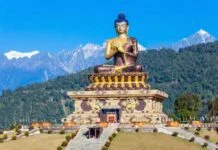Supreme Court issued landmark ruling on Article 370
The Supreme Court delivered a groundbreaking verdict on Article 370, constitutionally affirming Parliament’s decision made on August 5, 2019, to render Article ineffective. This Article had previously granted special status to the former state of Jammu and Kashmir.
The Court upheld the decision to revoke Article 370, highlighting its temporary nature and affirming the President’s authority to nullify it. The process initiated by the Modi government to abolish Article was validated by the Supreme Court. In a move supporting the Central Government, the Court affirmed that Jammu and Kashmir is an integral part of India and does not possess internal sovereignty.
The bench, comprising Justice DY Chandrachud, Justice Sanjay Kishan Kaul, Justice Sanjeev Khanna, Justice BR Gavai, and Justice Surya Kant, delivered the verdict on Article 370. The Court’s decision provided relief to the Central Government, asserting that Article 370 was meant for the constitutional integration of the Union of Jammu and Kashmir with India and not for dissolution.
It emphasized that the President holds the authority to declare the cessation of Article 370. On August 5, 2019, President Ramnath Kovind issued Constitutional Order (CO) 272, amending Article 367 of the Constitution. The order substituted the mention of the Constituent Assembly in Article 370(3) with the term Legislative Assembly.
Shortly after this presidential order, the Rajya Sabha recommended the cessation of Article 370. This move vested the Assembly’s authority in the Governor, allowing Parliament to legislate on behalf of the Governor.
Home Minister Amit Shah, on August 5, 2019, presented a resolution in the Rajya Sabha affirming the President’s authority to revoke Article 370 through a public notification under Article 370(3). The President issued such a notification, given that the powers of the Constituent Assembly had transferred to the Jammu and Kashmir Legislative Assembly.
With the state under President’s rule, the Parliament assumed the Legislative Assembly’s powers. Consequently, after the President’s order, the Parliament could pass it with a simple majority. The Supreme Court deemed the utilization of the President’s power to issue a constitutional order abolishing Article 370 as legitimate.
This ruling extended all provisions of the Indian Constitution to Jammu and Kashmir. Chief Justice D.V. Chandrachud emphasized that the President’s action was within legitimacy, stating, “We consider the use of the President’s power to issue a constitutional order to abrogate Article 370 of the Constitution as legitimate.
There was never any intention to make the Constituent Assembly of Jammu and Kashmir a permanent body.” During the proceedings, Chief Justice DY Chandrachud remarked, “There was no mention of sovereignty in the Constitution of Jammu and Kashmir; however, it is mentioned in the Preamble of the Constitution of India.”
He further stated, “Article 370 was aimed at constitutional integration, and its removal is constitutionally justified. The President holds the power to make such decisions.” The Court directed that statehood be reinstated to the Union Territory of Jammu and Kashmir at the earliest and mandated the Election Commission to organize elections in the region by September 2024.
Notably, Justices Sanjay Kishan Kaul and Sanjeev Khanna issued separate opinions. Justice Sanjay Kishan Kaul proposed the formation of an unbiased committee to investigate human rights violations dating back to the 1980s and suggested measures for peace restoration. He emphasized that Article 370 aimed to gradually align Jammu and Kashmir with other states of India.
Justice Khanna, in delivering the judgment, highlighted that Article 370 represented asymmetric federalism and was not indicative of Jammu and Kashmir’s sovereignty. He clarified that the abolition of Article 370 would not terminate federalism. The Supreme Court’s decision came after a challenge was lodged by various parties and individuals from Jammu and Kashmir against the Central Government’s proposal.
Following 16 days of hearings, the court reserved its judgment on September 5. Recalling the historic event of August 5, 2019, it was when the Central Government tabled a bill in Parliament for the removal of Article 370 from the Constitution of Jammu and Kashmir, subsequently leading to its repeal.
The Supreme Court’s decision carried significant implications, paving the way for the extension of all provisions of the Indian Constitution to Jammu and Kashmir. Chief Justice D.V. Chandrachud underscored the legitimacy of the President’s action in revoking Article 370, emphasizing that the intent was never to establish the Constituent Assembly of Jammu and Kashmir as a permanent body.





